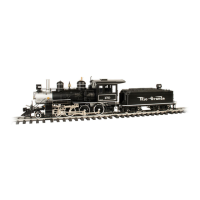1. Motor Switch (left-hand side tender front): This switch controls the motor. When “OFF,” the locomotive will not
move but the other features of the locomotive (such as smoke or lighting) will continue to function when power is
supplied to the locomotive.
2. Track Polarity Switch (middle tender front): In Large Scale, there are two conventions used to control the direction of
the locomotive. For left-rail positive control (the most common in use), move the polarity switch to the “Large Scale”
position. For right-rail positive control, move the polarity switch to the “NMRA” position. If your locomotive
operates in the reverse direction to other locomotives on your layout, place the polarity switch in the opposite position.
3. Pickup Switch (right-hand side tender front): In the “Track” position, track power is fed from the track to the
electronics inside the locomotive. In the “Battery” position, all track connections are removed and all the power is fed
through the two screw terminals labeled “INPUT BATT1” on the engineer’s side, behind the main circuit board.
4. Chuff Switch (small switch next to the polarity switch): The chuff switch is used to select either 2 or 4 chuffs per
drive wheel revolution.
PLUG-AND-PLAY SOCKET
This Bachmann locomotive comes equipped with a
nonproprietary plug-and-play electronics socket. This
socket is designed to accommodate aftermarket plug-and-
play products (contact your local hobby retailer for more
information). As delivered, the locomotive has a (DC)
Jumper PC Board in the socket (Figure 19).
19
Shown with (DC) Jumper PC Board in place.

